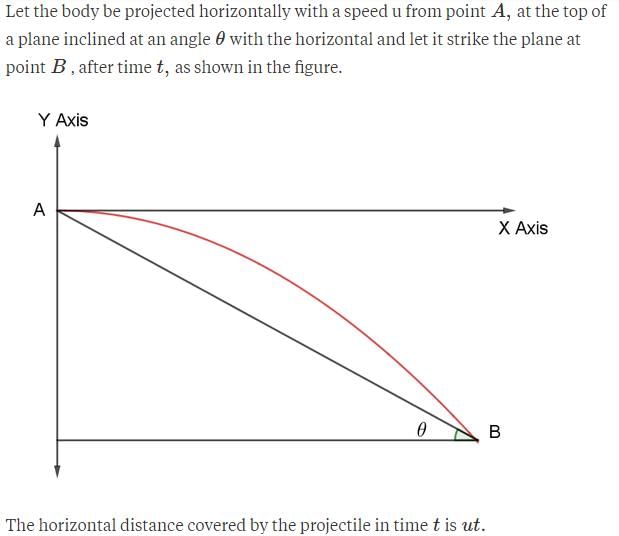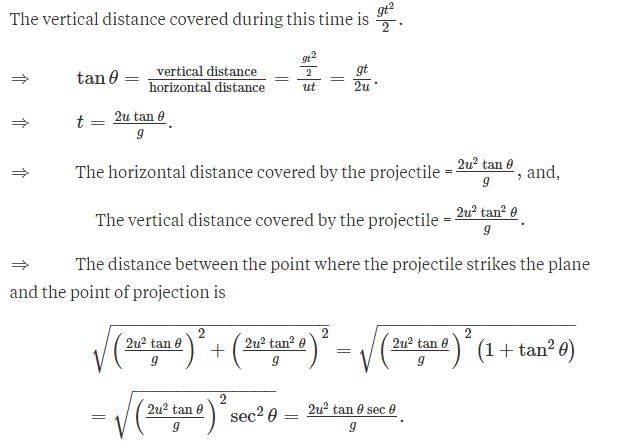JEE Exam > JEE Questions > A particle is projected horizontally with spe...
Start Learning for Free
A particle is projected horizontally with speed V is equal to 5 metre per second from the top of a plane incline at an angle theta is equal to 37 to the horizontal as shown in figure?
Verified Answer
A particle is projected horizontally with speed V is equal to 5 metre ...
Ans.
Method to Solve :




 This question is part of UPSC exam. View all JEE courses
This question is part of UPSC exam. View all JEE courses
Most Upvoted Answer
A particle is projected horizontally with speed V is equal to 5 metre ...
Introduction:
In this scenario, a particle is projected horizontally from the top of a plane incline at an angle of 37 degrees to the horizontal. The particle has an initial speed of 5 meters per second. We will analyze the motion of the particle and explain the key concepts involved.
Projectile Motion:
When a particle is projected with an initial horizontal velocity and an initial vertical velocity, it follows a curved path known as projectile motion. The horizontal and vertical motions are independent of each other.
Components of Velocity:
The initial velocity of the particle can be resolved into its horizontal and vertical components. The horizontal component (Vx) remains constant throughout the motion, while the vertical component (Vy) changes due to the effect of gravity.
Horizontal Motion:
Since the particle is projected horizontally, its initial vertical velocity is zero. Therefore, it only experiences horizontal motion. The horizontal distance covered by the particle is given by the formula:
- Range = Vx * Time of Flight
Vertical Motion:
The particle experiences vertical motion due to the effect of gravity. The initial vertical velocity (Vy) is zero, and the acceleration due to gravity (g) acts in the downward direction. The vertical displacement (h) can be determined using the formula:
- h = (1/2) * g * t^2
Time of Flight:
The time taken by the particle to reach the same vertical position from where it was projected is known as the time of flight. It can be calculated using the formula:
- Time of Flight = 2 * Vy / g
Range:
The horizontal distance covered by the particle is known as the range. It can be calculated using the formula:
- Range = Vx * Time of Flight
Conclusion:
In conclusion, when a particle is projected horizontally from the top of a plane incline, its motion can be analyzed using the principles of projectile motion. The horizontal component of velocity remains constant, while the vertical component is affected by gravity. The range and time of flight can be calculated using the given initial velocity and angle of projection. Understanding these concepts helps in predicting the trajectory of the particle and its landing position.
In this scenario, a particle is projected horizontally from the top of a plane incline at an angle of 37 degrees to the horizontal. The particle has an initial speed of 5 meters per second. We will analyze the motion of the particle and explain the key concepts involved.
Projectile Motion:
When a particle is projected with an initial horizontal velocity and an initial vertical velocity, it follows a curved path known as projectile motion. The horizontal and vertical motions are independent of each other.
Components of Velocity:
The initial velocity of the particle can be resolved into its horizontal and vertical components. The horizontal component (Vx) remains constant throughout the motion, while the vertical component (Vy) changes due to the effect of gravity.
Horizontal Motion:
Since the particle is projected horizontally, its initial vertical velocity is zero. Therefore, it only experiences horizontal motion. The horizontal distance covered by the particle is given by the formula:
- Range = Vx * Time of Flight
Vertical Motion:
The particle experiences vertical motion due to the effect of gravity. The initial vertical velocity (Vy) is zero, and the acceleration due to gravity (g) acts in the downward direction. The vertical displacement (h) can be determined using the formula:
- h = (1/2) * g * t^2
Time of Flight:
The time taken by the particle to reach the same vertical position from where it was projected is known as the time of flight. It can be calculated using the formula:
- Time of Flight = 2 * Vy / g
Range:
The horizontal distance covered by the particle is known as the range. It can be calculated using the formula:
- Range = Vx * Time of Flight
Conclusion:
In conclusion, when a particle is projected horizontally from the top of a plane incline, its motion can be analyzed using the principles of projectile motion. The horizontal component of velocity remains constant, while the vertical component is affected by gravity. The range and time of flight can be calculated using the given initial velocity and angle of projection. Understanding these concepts helps in predicting the trajectory of the particle and its landing position.
Attention JEE Students!
To make sure you are not studying endlessly, EduRev has designed JEE study material, with Structured Courses, Videos, & Test Series. Plus get personalized analysis, doubt solving and improvement plans to achieve a great score in JEE.

|
Explore Courses for JEE exam
|

|
Similar JEE Doubts
A particle is projected horizontally with speed V is equal to 5 metre per second from the top of a plane incline at an angle theta is equal to 37 to the horizontal as shown in figure?
Question Description
A particle is projected horizontally with speed V is equal to 5 metre per second from the top of a plane incline at an angle theta is equal to 37 to the horizontal as shown in figure? for JEE 2024 is part of JEE preparation. The Question and answers have been prepared according to the JEE exam syllabus. Information about A particle is projected horizontally with speed V is equal to 5 metre per second from the top of a plane incline at an angle theta is equal to 37 to the horizontal as shown in figure? covers all topics & solutions for JEE 2024 Exam. Find important definitions, questions, meanings, examples, exercises and tests below for A particle is projected horizontally with speed V is equal to 5 metre per second from the top of a plane incline at an angle theta is equal to 37 to the horizontal as shown in figure?.
A particle is projected horizontally with speed V is equal to 5 metre per second from the top of a plane incline at an angle theta is equal to 37 to the horizontal as shown in figure? for JEE 2024 is part of JEE preparation. The Question and answers have been prepared according to the JEE exam syllabus. Information about A particle is projected horizontally with speed V is equal to 5 metre per second from the top of a plane incline at an angle theta is equal to 37 to the horizontal as shown in figure? covers all topics & solutions for JEE 2024 Exam. Find important definitions, questions, meanings, examples, exercises and tests below for A particle is projected horizontally with speed V is equal to 5 metre per second from the top of a plane incline at an angle theta is equal to 37 to the horizontal as shown in figure?.
Solutions for A particle is projected horizontally with speed V is equal to 5 metre per second from the top of a plane incline at an angle theta is equal to 37 to the horizontal as shown in figure? in English & in Hindi are available as part of our courses for JEE.
Download more important topics, notes, lectures and mock test series for JEE Exam by signing up for free.
Here you can find the meaning of A particle is projected horizontally with speed V is equal to 5 metre per second from the top of a plane incline at an angle theta is equal to 37 to the horizontal as shown in figure? defined & explained in the simplest way possible. Besides giving the explanation of
A particle is projected horizontally with speed V is equal to 5 metre per second from the top of a plane incline at an angle theta is equal to 37 to the horizontal as shown in figure?, a detailed solution for A particle is projected horizontally with speed V is equal to 5 metre per second from the top of a plane incline at an angle theta is equal to 37 to the horizontal as shown in figure? has been provided alongside types of A particle is projected horizontally with speed V is equal to 5 metre per second from the top of a plane incline at an angle theta is equal to 37 to the horizontal as shown in figure? theory, EduRev gives you an
ample number of questions to practice A particle is projected horizontally with speed V is equal to 5 metre per second from the top of a plane incline at an angle theta is equal to 37 to the horizontal as shown in figure? tests, examples and also practice JEE tests.

|
Explore Courses for JEE exam
|

|
Suggested Free Tests
Signup for Free!
Signup to see your scores go up within 7 days! Learn & Practice with 1000+ FREE Notes, Videos & Tests.

























